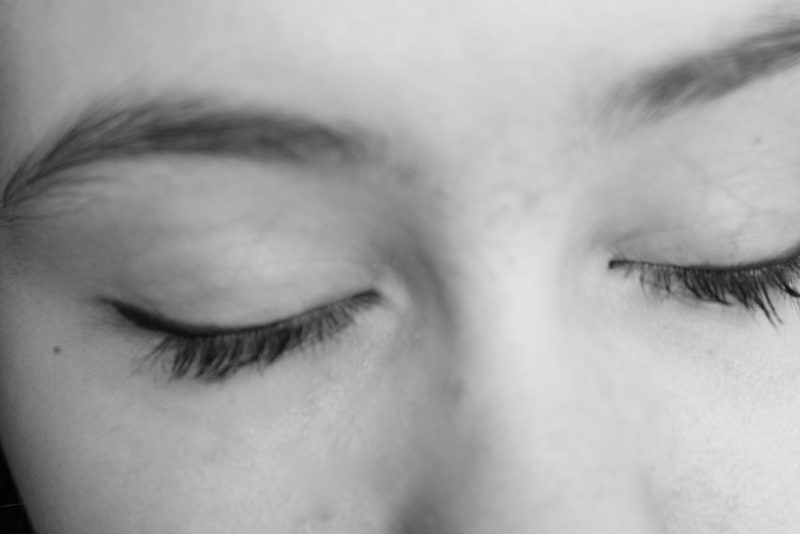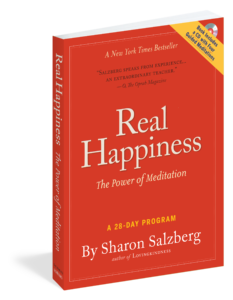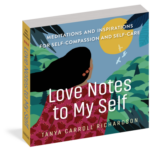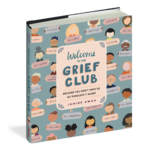Start your week off mindfully with this thinking meditation practice, excerpted from Sharon Salzberg’s Real Happiness.

Sit or lie comfortably. You can close your eyes, or keep them open, whichever makes you feel most at ease. Feel the space within which you’re sitting, touching you from all directions; you don’t need to reach out. Feel the ground underneath you. Notice how the earth is supporting you; you don’t have to manufacture that—you can trust it.
Let your attention settle on the feeling of the breath. You can notice that the breath is coming and going, according to its own rhythm, filling your body, and leaving, connecting you to the world around you. You can receive it, let it go. It’s happening without your needing to control it; you can settle back and allow it.
See what thoughts may be present in your awareness. You might think of them as events in the mind. And when a thought arises that’s strong enough to take your attention away from the breath, simply notice it as thinking. You can note it—thinking, thinking—no matter the content. Whether it’s a lovely thought or an awful one, it’s just a thought.
If you’re able to, note the thought more distinctly, planning, remembering, worrying, anticipating. Don’t struggle to find the right word, but if one comes clearly, use it and see what happens as you note the thought. You don’t have to judge yourself, you don’t have to get lost in the thought, or elaborate it; you recognize that it’s simply a thought. Very gently let go and bring your attention back to the feeling of the breath.
Some of our thoughts may be tender and caring, some may be very painful or hurtful, but they’re all thoughts. Remember the image of thoughts as clouds moving across the sky. Some are very light and fluffy, very inviting. Some are quite ominous and threatening. And you can just let them all float on by. See them, recognize them, let them go, bring your attention back to the feeling of the breath.
Our habitual tendency is to grab on to a thought and build an entire world around it, or push it away and struggle against it. Here we stay even, balanced, calm. We simply recognize it’s a thought; it’s not who I really am. By its very nature a thought, however intense, is impermanent; it is visiting, it is arising due to conditioning or habit. Very gently let it go. Bring your attention back, one breath at a time.
Again feel the space within which you’re sitting and how it touches you from all directions. Feel the ground underneath you, supporting you. Notice how the space is touching you, notice how the earth is supporting you. You can feel these things, and you can trust them. Open your eyes and relax.
 About the Book:
About the Book:
Thousands of years prove it, and Western science backs it: Meditation sharpens focus. Meditation lowers blood pressure, relieves chronic pain, reduces stress. Meditation helps us experience greater calm. Meditation connects us to our inner-most feelings and challenges our habits of self-judgment. Meditation helps protect the brain against aging and improves our capacity for learning new things. Meditation opens the door to real and accessible happiness.
There is no better person to show a beginner how to harness the power of meditation than Sharon Salzberg, one of the world’s foremost meditation teachers and spiritual authors. Cofounder of the Insight Meditation Society, author of Lovingkindness, Faith, and other books, Ms. Salzberg distills 30 years of teaching meditation into a 28-day program that will change lives. It is not about Buddhism, it’s not esoteric—it is closer to an exercise, like running or riding a bike. From the basics of posture, breathing, and the daily schedule to the finer points of calming the mind, distraction, dealing with specific problem areas (pain in the legs? falling asleep?) to the larger issues of compassion and awareness, Real Happiness is a complete guide. It explains how meditation works; why a daily meditation practice results in more resiliency, creativity, peace, clarity, and balance; and gives twelve meditation practices, including mindfulness meditation and walking meditation. An extensive selection of her students’ FAQs cover the most frequent concerns of beginners who meditate—“Is meditation selfish?” “How do I know if I’m doing it right?” “Can I use meditation to manage weight?”
Buy the Book
Amazon | B&N | Indiebound | Workman




No Comments